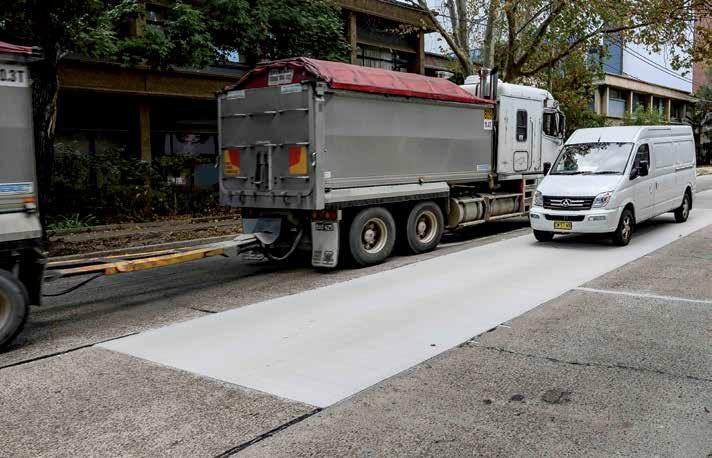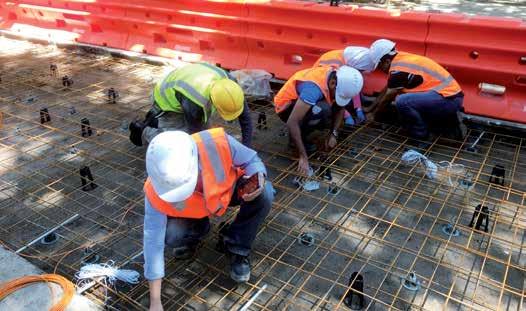
9 minute read
City of Sydney
INDUSTRIAL WASTE CONCRETE TRIAL
THE CITY OF SYDNEY AND THE UNIVERSITY OF NEW SOUTH WALES ARE TESTING CONCRETE MADE USING INDUSTRIAL WASTE FROM COAL-FIRED POWER STATIONS AND STEEL MANUFACTURING.
According to UK non-governmental organisation Royal Institute of International Affairs, cement is the source of around eight per cent of the world’s carbon dioxide emissions every year.
The extensive carbon footprint has for decades prompted researchers to look for new and greener solutions to construction.
One alternative that has been looked at is geopolymer concrete. The material aims to significantly reduce CO2 emissions and is made using recycled industrial materials.
Geopolymer concrete has been researched since the 1990s, including in the research paper Geopolymeric concretes For Environmental Protection, published in Concrete International in 1990.
However, despite ongoing research efforts, practical results showing its durability and performance have only come into the spotlight during the last five years.
For the first time, the City of Sydney is trialling geopolymer concrete on a busy city road. It estimates the alternative only produces 300 kilograms of CO2 per tonne compared to 900 kilograms per tonne with traditional concrete.
The City of Sydney is trialling the geopolymer concrete on Wyndham Street in Alexandria, a road leading to the airport. The concrete is made using fly ash from coal-fired power plants and blast furnace slag, a bi-product of the steel manufacturing industry.
The road has been constructed with 15 metres of traditional concrete and 15 metres of the ‘green’ geopolymer concrete. The even spread ensures each section receives the exact same amount of traffic.
Lord Mayor of the City of Sydney Clover Moore says projects like this can result in new products that can make a real difference
in reducing carbon emissions.
“Local governments are responsible for maintaining local roads. If we can purchase more environmentally sustainable materials, we can fight climate change and provide quality infrastructure for our community. ”
She says with 70 per cent of the concrete produced going into pavements and footpaths, there’s great potential to lower emissions from their operations.
The strip of concrete will be monitored over five years by the University of New South Wales (UNSW) and the Cooperative Research Centre for Low Carbon Living (CRCLCL).
Team will use results from the trial to create the first set of industry guidelines for geopolymer concrete.
Professor Stephen Foster, Project Lead and Head of School of Civil and Environmental Engineering at UNSW, says the trial is a huge step forward.
“This concrete compared to conventional concrete will halve the amount of CO2 produced in the process of making it,” Dr. Foster says.
Dr. Foster says despite being researched for nearly 30 years, the CRCLCL identified research gaps around the durability and performance of the concrete over the last five years.
He says now there is sufficient research to have confidence in the concrete’s performance.
The UNSW has performed a series of trials in a lab to determine the durability of geopolymer concrete to ensure it could perform to a high standard. For this trial, the university used commercial geopolymer concrete to demonstrate their findings.
The product is already commercialised by some small companies such as Wagners and Zeobond. For large uptake, Dr. Foster believes engineers need to have widespread confidence in its performance.
“This trial will help us to create a handbook to give engineers and owners confidence that if they use this material they won’t be ripping the road up in five to 10 years time,” Dr. Foster says.
He says the tests are incredibly important to demonstrate a product’s performance, particularly as it will be verified by an independent body, as opposed to a commercial operation. Standards Australia will develop the handbook for geopolymer concrete and its quality for industry use.
Dr. Foster’s current prediction for the test is there will be no difference between the performance of the geopolymer concrete and the traditional concrete.
“We expect the geopolymer concrete to perform at least as well as conventional concrete, if not better,” he says.
When monitoring the road the researchers will take two approaches: The first is visual, at the start of the trial photos were taken of the entire road surface. The team will then monitor those images for any visible changes. The second is through sensors, nine were placed into the concrete slab to collect data on its movement.
“We are in the process now of getting the data loggers for the sensors up and we will be able to measure or see in real time how and if there are any changes to the performance of the slab remotely,” Dr. Foster says.
He says the team will monitor the road over a period of five years but after one year it will have a large amount of data and should be able to make reliable predictions of its durability.
“We will be looking to see the quality of its abrasion resistance, how well it will hold up under a traffic load and we will also monitor how well the concrete resists water and salt to determine if there is a faster or slower corrosion of the reinforcing steel inside the slab,” Dr. Foster says.
Once the durability and quality of the geopolymer concrete is proved, it is hoped the product will be scaled up for use
Results from the trial will be used to create the first set of industry guidelines for geopolymer concrete.

industry wide.
The only difference in the making and construction of geopolymer concrete from traditional concrete is changing the mix design. Dr. Foster says there should be no discernible difference for on-site workers between geopolymer and traditional concrete.
“The main thing is, it uses the same equipment mostly as conventional concrete and there will be almost no requirement for retraining the workforce. As it is made and applied with the same equipment there is almost no cost involved,” he says.
While Dr. Foster acknowledges some government specifications may limit the use of geopolymer concrete, or any concrete with a certain amount of recycled material, he is hopeful this will change.
“I think one of the key things to avoid is being prescriptive in the way specifications are developed. At the moment there’s too much prescription by some government authorities. Specifications should focus on the performance a product needs to give and then let industry innovate around that,” Dr. Foster says.
He believes in the near future concrete will evolve to be more sustainable and all governments need to allow this.
“Whether it’s changing conventional concrete by using less cement and more biproducts or using waste products such as the fly ash, or using a replacement product such as geopolymer concrete to take all of the cement out, the whole industry is moving to try and reduce its carbon footprint.”
CONTRACTS -- IN BRIEF
ROADS & INFRASTRUCTURE PROVIDES AN UPDATE ON SOME OF THE MAJOR PROJECT CONTRACTS AND TENDERS RECENTLY AWARDED AND OUT TO MARKET ACROSS THE AUSTRALASIAN INFRASTRUCTURE SECTOR.
NORTHERN TERRITORY Keep River Road $58M contract awarded A $58 million tender to upgrade Keep River Road has been awarded to a local company in the Northern Territory. Exact Contracting won the contract, which is expected to deliver more than 100 local jobs. Works will be delivered in two stages. The first stage includes the upgrade of 13.4 kilometres from the WA border to a two-lane road toward the Legune Station, and a bridge over the Keep River.
NEW SOUTH WALES Joint venture awarded $74M defence construction contract The Georgiou Group and Brady Marine and Civil have won the $74 million contract for stage one of the Garden Island (east) critical infrastructure recovery project in NSW. The contract involves the construction of new, re-aligned wharf structures at the Garden Island Defence Precinct in Port Jackson. Construction is expected to employ 50 people at peak and commenced in July, with an estimated completion date of March 2021.

QUEENSLAND EOI’s open for $70M QLD BoR program Expressions of interest are open for round five of Queensland’s Building our Regions (BoR) program, with $70 million available to support local government infrastructure projects in regional communities. State Development and Infrastructure Minister Cameron Dick said regional Queensland councils will have until 30 August to submit expressions of interest for shovel-ready projects.
TASMANIA Mowbray Connector upgrade contract The construction contract for Tasmania’s $5 million East Tamar Highway – Mowbray Connector Intersection Upgrade has been awarded to Shaw Contracting. Infrastructure Minister Michael Ferguson said the contract includes installation of a roundabout to replace the current turning arrangement at the intersection of East Tamar Highway and Mowbray Link. Works are scheduled to begin in September and finish early next year.
VICTORIA Alliance contracted for Evans Road level crossing removal Site works have begun after the $54 million contract to remove the Evans Road level crossing was awarded. Metro Trains Melbourne and Fulton Hogan will oversee the project to remove the level crossing and construct a road bridge. The project has been fast tracked to coincide with other nearby road upgrades and is expected to be completed in 2020.
Contract awarded for O’Herns Road stage two VEC Civil Engineering has been awarded the construction contract for stage two of the O’Herns Road Upgrade in Epping, Victoria. VEC will build new intersections at Edgars Road, Gateway Boulevard and Koukoura Drive with traffic lights. The upgrade also includes a diamond interchange, providing direct access to the Hume Freeway, and a new lane in each direction between the Hume Freeway and Redding Rise.
SOUTH AUSTRALIA Contract awarded for $354M North-South Corridor Urban Infrastructure Minister Alan Tudge has announced successful tender for the major works contract on the $354.3 million North-South Corridor – Regency Road to Pym Street Project. A consortium of McConnell Dowell Constructors, Mott MacDonald Australia and Arup Group will design and construct a new 1.8 kilometre motorway along South Road, connecting the South Road Superway to the Torrens to Torrens Project.
SA opens EOI’s and tenders worth over $300M The South Australian Government is continuing to build its regional road network, releasing expressions of interest (EOI) and tenders for three road projects worth over $300 million. The projects are jointly funded by the federal and state governments and include the $200 million Joy Baluch AM Bridge Duplication, $90 million Port Wakefield Overpass and Highway Duplication and $14.6 million Penola Northern Bypass.
WESTERN AUSTRALIA $5.8M Jetty Road contract awarded A Western Australian company has been awarded a $5.8 million contract to complete Jetty Road causeway upgrades at Casuarina Boat Harbour. Densford Civil successfully tendered for phase two of the upgrade, which includes the reconstruction of Jetty Road, increased parking with 164 bays, the introduction of shared paths and landscaping, construction of a multipurpose building and improvements to utility services in the area.
A N E W D A Y. BUILDING TOGETHER.
A N E W D E E R E.

Dedicated, focused dealers ready to partner with you. It’s a New Day and a New Deere.
FROM TOP TO BOTTOM, WE SUPPLY THE BEST CONSULTATION AND TECHNOLOGY TO BUILD YOUR AUSTRALIAN ROADS. STRAIGHT UP.











